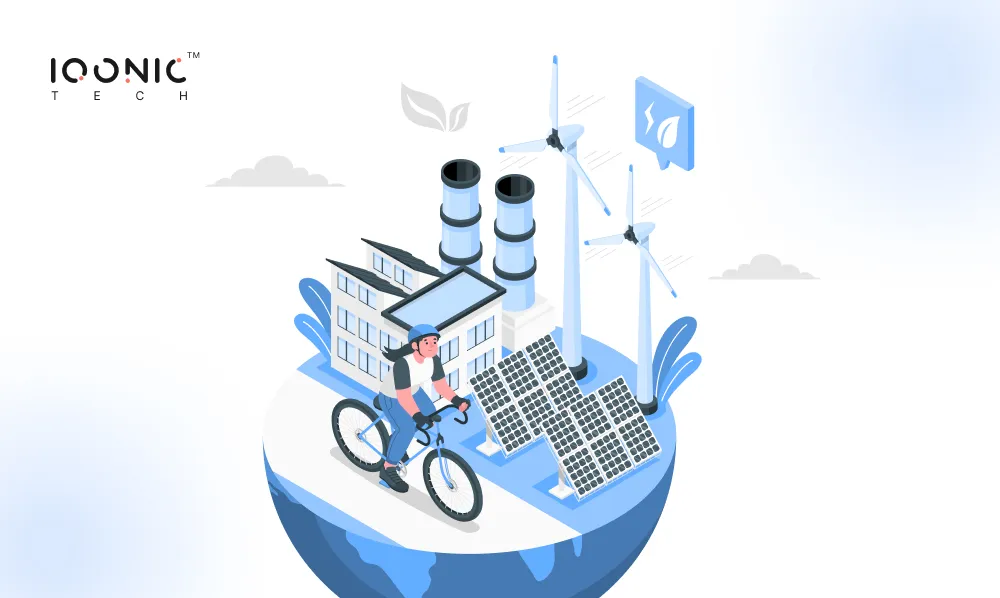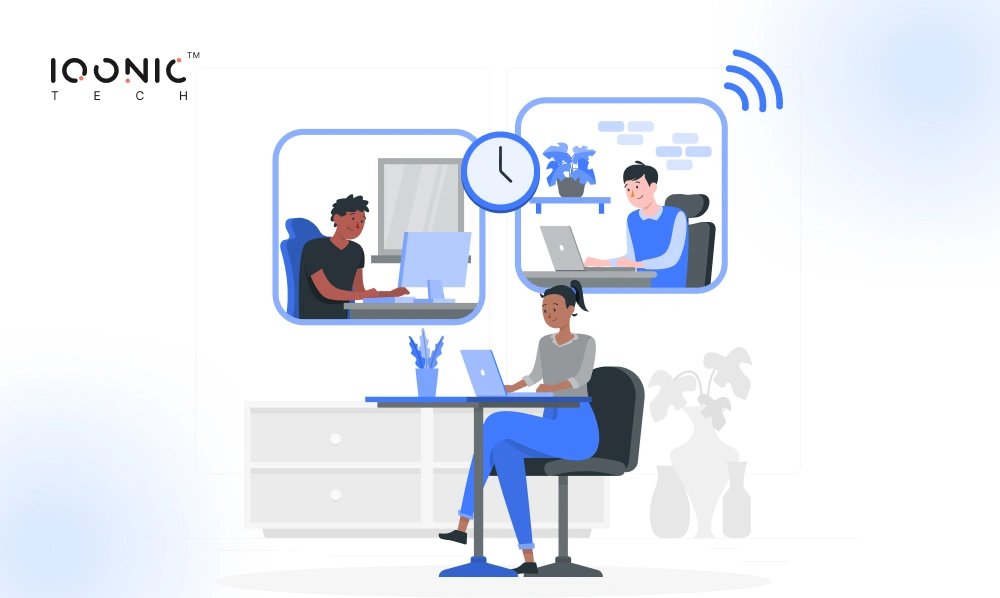Green technology is revolutionizing cities’ growth and function, paving the way for a sustainable and eco-friendly future. These innovations are vital to addressing critical urban challenges, such as air pollution, overpopulation, and the depletion of natural resources. By integrating green tech solutions into urban planning, cities can reduce their carbon footprint while enhancing the quality of life for their residents. Leveraging green technology for the environment, urban planners are creating eco-friendly spaces that prioritize sustainability.
Here’s what this blog will explore:
- How green tech contributes to sustainable urban development.
- The impact of smart city technologies on urban spaces.
- Key innovations like renewable energy and green building practices.
- The future of eco-friendly urban solutions and the challenges ahead.
The transformation of cities with green technology isn’t just a trend; it’s necessary for a better tomorrow.
How Green Technology Drives Sustainable Urban Growth
Green technology is pivotal in driving sustainable urban development. It enables cities to grow while minimising their environmental impact. By integrating renewable energy sources, improving waste management, and adopting eco-friendly urban solutions, cities can become more energy-efficient and resilient to the challenges posed by climate change.
Key initiatives contributing to sustainable urban development include. These initiatives highlight the importance of technological solutions to environmental problems in modern metropolitan areas.
a. Renewable energy integration:
Solar panels and wind turbines power homes and businesses, reducing dependence on fossil fuels.
b. Smart water systems:
Technologies like rainwater harvesting and recycling ensure efficient resource use.
c. Eco-friendly urban planning:
Cities incorporate more green spaces, such as parks and rooftop gardens, to improve air quality and enhance urban living.
For example, Copenhagen leads in sustainable urban development with its extensive bike infrastructure and focus on renewable energy. It serves as a model for cities worldwide. By embracing such solutions, urban areas can thrive sustainably while protecting the planet.
Smart City Technologies Revolutionizing Urban Spaces
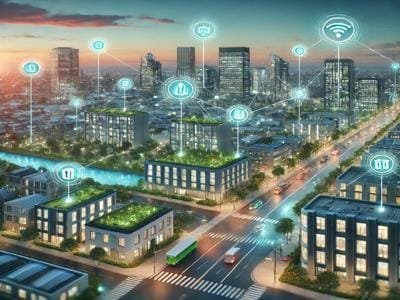
Integrating smart city technologies transforms urban living by enhancing efficiency, reducing resource wastage, and improving environmental sustainability. These technologies use advanced systems like the Internet of Things (IoT) to optimize city functions and improve residents’ quality of life.
Key smart city technologies include:
1. IoT-based energy systems:
Smart grids monitor energy consumption and distribute power efficiently, reducing energy loss.
2. Intelligent traffic management:
Real-time data helps control traffic flow, reducing congestion and emissions.
3. Smart waste management systems:
IoT-enabled bins monitor waste levels, ensuring timely collection and reducing landfill dependency. Cities adopting sustainable solutions for waste management report significant reductions in environmental impact.
4. Smart lighting systems:
Motion-sensor street lights save energy by operating only when needed.
For example, Singapore has implemented intelligent traffic solutions that significantly reduce commute times, while Barcelona uses IoT-based waste systems to streamline garbage collection. These innovations highlight how smart city technologies can make urban spaces more livable and sustainable.
Renewable Energy Solutions Powering Tomorrow's Cities
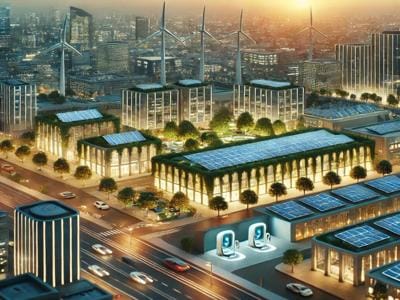
Integrating renewable energy into cities is a cornerstone of sustainable urban development. It enables cities to reduce their reliance on fossil fuels while meeting energy demands. Metropolitan areas increasingly turn to innovative renewable technologies to power buildings, transportation systems, and public infrastructure.
Key renewable energy solutions include:
A. Solar energy:
Solar panels on rooftops and public spaces generate clean energy for homes and offices.
B. Wind energy:
Urban wind turbines harness wind power to supply electricity in dense city environments.
C. Geothermal
Geothermal systems provide sustainable heating and cooling for residential and commercial buildings.
D. Electric vehicle charging stations
Electric vehicle charging stations, widely available in cities like Amsterdam and San Francisco, support the transition to clean transportation.
For example, Copenhagen derives nearly 50% of its energy from wind turbines, while Freiburg, Germany, is a leader in solar-powered infrastructure. These projects showcase how renewable energy solutions are powering the cities of tomorrow.
Green Building Practices for Urban Sustainability
Adopting green building practices is essential for creating low-carbon cities and combating climate change. These practices involve designing and constructing buildings using sustainable materials, energy-efficient systems, and innovative technologies that minimise environmental impact.
Key aspects of green building practices include:
1. Sustainable materials:
Using recycled or locally sourced materials reduces construction’s carbon footprint.
2. Energy-efficient designs:
Features like insulation, energy-saving windows, and solar panels lower energy consumption.
3. Water conservation systems:
Rainwater harvesting and efficient plumbing systems reduce water waste.
A prominent example is the Bosco Verticale in Milan, Italy. This “vertical forest” incorporates greenery into building facades, improving air quality and energy efficiency. Additionally, LEED (Leadership in Energy and Environmental Design) certifications play a vital role by encouraging builders to meet high environmental standards.
Urban areas can significantly reduce their carbon emissions and promote sustainable development by implementing these strategies.
Sustainable Transportation Systems for a Low-Carbon Future
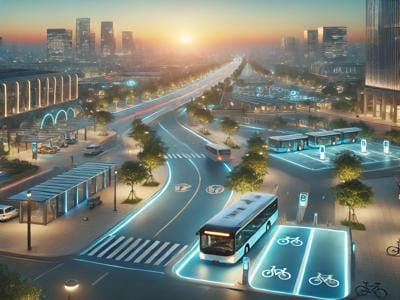
Developing sustainable transportation systems is a vital step toward building low-carbon cities. Urban areas can reduce greenhouse gas emissions, improve air quality, and create healthier living environments by shifting to eco-friendly mobility options.
Key innovations in sustainable transportation include:
a. Electric public transport:
Cities like Copenhagen have introduced fleets of electric buses that reduce emissions and operate quietly.
b. Shared mobility solutions:
Ride-sharing apps and carpooling services lower the number of vehicles on the road, easing congestion and cutting emissions.
c. Bicycle-friendly infrastructure:
Amsterdam’s extensive network of bike lanes and parking facilities makes cycling a primary mode of transportation for many residents. Expanding sustainable transportation systems is critical for reducing urban carbon emissions.
d. Electric vehicle (EV) adoption:
Widespread EV charging stations in cities like Oslo promote using electric cars, reducing reliance on fossil fuels.
By investing in these systems, urban areas can create efficient and eco-friendly transit networks, ensuring a sustainable future for future generations.
Urban Climate Resilience Through Green Tech
Green technology is key to strengthening urban climate resilience and helping cities adapt to climate change challenges. Urban areas can mitigate risks like flooding, heat waves, and water scarcity by adopting innovative solutions while ensuring long-term sustainability.
Effective practices that enhance urban climate resilience include:
I. Urban afforestation:
Planting trees and creating green belts reduce heat islands and improve air quality.
II. Rainwater harvesting:
Collecting and reusing rainwater ensures a steady supply for urban needs, even during droughts.
III. Smart water systems
Monitor and optimise water usage, prevent waste, and support efficient management. They are prime examples of environmental technical solutions that effectively address urban challenges.
For instance, Singapore’s extensive rainwater harvesting infrastructure and vertical gardens are prime examples of how cities can use green technology to address climate challenges. These practices protect the environment and reduce the long-term economic costs of climate-related disasters.
Challenges in Adopting Green Tech Innovations
The transition to green technology faces several challenges that cities must address to ensure widespread adoption. Key hurdles include:
A. High initial costs:
Installing green tech solutions like renewable energy systems or smart grids requires significant upfront investment.
B. Lack of awareness:
A limited understanding of the benefits and potential of green technology can slow its acceptance.
C. Resistance to change:
People and institutions often hesitate to adopt new methods due to comfort with traditional practices.
To overcome these challenges, cities can:
- Implement government incentives like tax breaks and subsidies to offset costs.
- Encourage collaboration between public and private sectors to combine resources and knowledge.
- Launch awareness campaigns to educate communities about green tech’s long-term environmental and economic benefits.
By addressing these issues with strategic solutions, cities can accelerate the shift toward a more sustainable future.
The Future of Eco-Friendly Urban Solutions
The future of cities lies in adopting advanced eco-friendly urban solutions prioritising sustainability and innovation. Emerging trends like AI-powered systems are set to revolutionise resource management, from optimising energy consumption to enhancing waste recycling processes. Adopting recycling management solutions allows cities to improve resource recovery and reduce landfill use. Similarly, the rise of the circular economy will ensure that materials and resources are reused, minimising waste and environmental harm.
Key advancements shaping tomorrow’s cities include:
i. AI-driven sustainability solutions:
Smart systems predict energy needs and reduce wastage.
ii. Circular economy models:
Industries design products with longevity and recyclability in mind.
As cities continue to embrace these technologies, they will reduce their ecological impact and create thriving, resilient communities for generations to come. The future of urban living is green, innovative, and full of possibilities.
